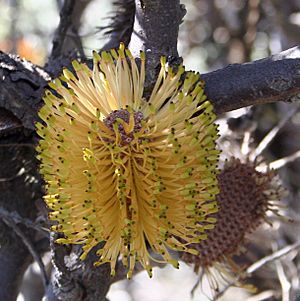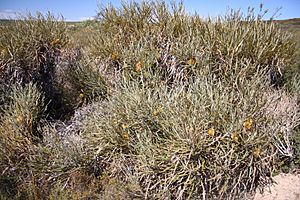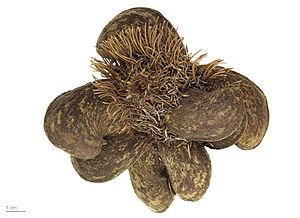Propeller banksia facts for kids
Quick facts for kids Propeller banksia |
|
|---|---|
 |
|
| Banksia candolleana, near Badgingarra | |
| Scientific classification | |
| Genus: |
Banksia
|
| Species: |
candolleana
|
| Synonyms | |
|
Sirmuellera candolleana (Meisn.) Kuntze |
|
The Propeller Banksia (Banksia candolleana) is a special type of shrub. It only grows in Western Australia. This plant gets its name from its unique leaves. They are shiny green and have deep, triangle-shaped edges. Its flowers are bright golden yellow. They grow in spikes on short branches.
Contents
What Does the Propeller Banksia Look Like?
This shrub has many branches. It usually grows about 0.5 to 1.3 meters (1.5 to 4 feet) tall. It can spread up to 2.5 meters (8 feet) wide. The plant has a special woody swelling underground called a lignotuber. This helps it regrow after a fire.
Leaves and Flowers
The leaves are long and narrow. They are about 1.5 to 4 centimeters (0.6 to 1.6 inches) long. They are also 0.6 to 2 centimeters (0.2 to 0.8 inches) wide. The leaves are shiny green. They have deep, triangle-shaped edges.
The flowers grow in oval-shaped spikes. These spikes are 1.5 to 4 centimeters (0.6 to 1.6 inches) long. They are 5.5 to 7.5 centimeters (2.2 to 3 inches) wide. The flowers are a beautiful golden yellow color. Each flower has a long, curved part called a pistil.
When Does it Flower?
Propeller Banksias bloom from April to July. After flowering, special seed pods form. These pods are called follicles. They are egg-shaped and curved. Each spike usually has up to five pods. The pods are 2 to 6.5 centimeters (0.8 to 2.6 inches) long. They are also 2.5 to 5 centimeters (1 to 2 inches) high. The old flowers stay around the pods.
Where Does the Propeller Banksia Live?
The Propeller Banksia is found in Western Australia. It grows from a town called Arrowsmith down to Gingin. This area is north of Perth. It likes sandy plains. It often grows in low kwongan areas. Kwongan is a type of shrubland. This region gets about 600 to 700 millimeters (24 to 28 inches) of rain each year.
How Does the Propeller Banksia Survive?
This plant is very tough. After a bushfire, it can regrow from its woody lignotuber. Some large Propeller Banksia shrubs are very old. Scientists think some might be 1,000 years old!
Animals and Pollination
Small animals visit the flowers. The white-tailed dunnart (a small marsupial) has been seen visiting the flowerheads. We don't know if it helps pollinate the flowers. Ants and bees also visit the flower spikes. This includes the European honeybee. They help spread the pollen.
Growing Propeller Banksia in Gardens
It takes a long time for Propeller Banksia to grow. It might take up to 10 years for a plant grown from seed to flower. It grows well in gardens with good drainage. It likes climates similar to the Mediterranean. This means warm, dry summers and mild, wet winters. It does not grow well in places with high humidity.
Planting Seeds
You don't need to do anything special to the seeds before planting. They usually sprout in about 22 to 35 days.



